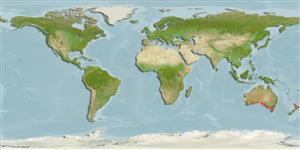أشلاق (القروش و الشفانين) (sharks and rays) >
Myliobatiformes (Stingrays) >
Myliobatidae (Eagle and manta rays)
Etymology: Myliobatis: Greek, mylo = mill + Greek, + Greek, batis,-idos = a ray (Raja sp.) (Ref. 45335).
More on author: Macleay.
Environment: milieu / climate zone / depth range / distribution range
البيئة
بحري مرتبطة بالشعاب; نطاق العمق 1 - 85 m (Ref. 9862). Subtropical; 27°S - 43°S
Eastern Indian Ocean: southern Australia, from Western Australia to Queensland. Possibly occurring off New Zealand.
الحجم / وزن / العمر
Maturity: Lm ? range ? - ? cm
Max length : 120 cm WD ذكر/ مختلط الجنس; (Ref. 6871); أعلا وزن تم نشرة: 56.5 kg (Ref. 40637)
Commonly found off beaches and over sand flats in shallow water. Also found offshore down to 85 m (Ref. 9862). Feeds mainly on crabs and shellfish (Ref. 6871). Ovoviviparous (Ref. 50449).
Life cycle and mating behavior
النضج | التكاثر | وضع البيض | بيض | الخصوبة | Larvae
Exhibit ovoviparity (aplacental viviparity), with embryos feeding initially on yolk, then receiving additional nourishment from the mother by indirect absorption of uterine fluid enriched with mucus, fat or protein through specialised structures (Ref. 50449).
Last, P.R. and J.D. Stevens, 1994. Sharks and rays of Australia. CSIRO, Australia. 513 p. (Ref. 6871)
IUCN Red List Status (Ref. 130435)
استخدامات بشرية
لعبة سمكه: نعم
مزيد من المعلومات
العمر/ الحجمنموالطول-الوزنالطول-الطولالطول- التردداتقياسات المظهر الخارجيالوصف الخارجيLarvaeحركة انتقال اليرقاتتوظيفالوفرةBRUVS
مراجعالأستزراع المائيملف الأستزراع المائيسلالاتجينيElectrophoresesالتوريثالأمراضمعالجةNutrientsMass conversion
أدوات
تقارير خاصة
Download XML
مصادر علي الأنترنت
Estimates based on models
Preferred temperature (Ref.
123201): 15 - 20.1, mean 17.4 °C (based on 236 cells).
Phylogenetic diversity index (Ref.
82804): PD
50 = 0.5002 [Uniqueness, from 0.5 = low to 2.0 = high].
Bayesian length-weight: a=0.00389 (0.00123 - 0.01235), b=3.08 (2.82 - 3.34), in cm total length, based on LWR estimates for this (Sub)family-body shape (Ref.
93245).
مستوى غذائي (Ref.
69278): 3.6 ±0.55 se; based on food items.
المرونه (Ref.
120179): منخفض, الحد الزمني الأدني لتضاعف عدد أفراد المجتمع 4.5-14 سنة (Fec assumed to be <100).
Fishing Vulnerability (Ref.
59153): Very high vulnerability (83 of 100).
Nutrients (Ref.
124155): Calcium = 4.25 [0.47, 67.92] mg/100g; Iron = 0.393 [0.033, 4.254] mg/100g; Protein = 21.5 [16.2, 26.7] %; Omega3 = 0.113 [0.037, 0.324] g/100g; Selenium = 15.7 [2.8, 83.7] μg/100g; VitaminA = 14.1 [1.2, 162.4] μg/100g; Zinc = 0.464 [0.031, 5.171] mg/100g (wet weight);
